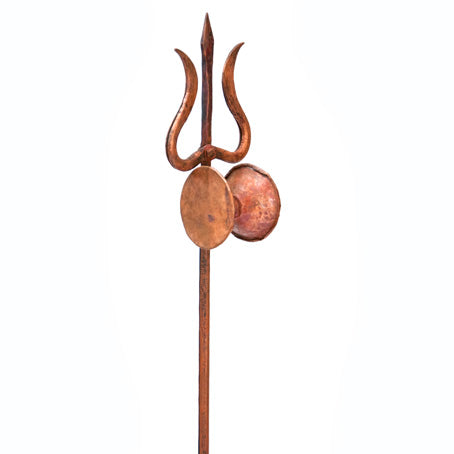Trishula

Trishula means “trident.” The Trishula (or, trisula) is the three-pronged sacred weapon of the Hindu deity Shiva. In a general sense, the trishula represents the deity in his three aspects of Creator, Preserver, and Destroyer. The trihsula (also spelled trishul or trisula, Sanskrit for "three spear") is a trident spear that is the emblem of the god Shiva. The weapon symbolizes empire and the irresistible force of transcendental reality.
Trishul symbolizes three fundamental powers or shakti of iccha, kriya and jnana – will, action and knowledge. Through progressive expansion of three shaktis, the Unmanifest impinges into universal experience.
The fearsome goddess Durga also brandishes a trishula in one of her seven hands.
The Trishula is the weapon of Shiva with which he destroys evils and ignorance to restore order. The Trishul stands for the triple qualities of nature, Prakritis, namely, sattva, rajas and tamas. Shiva is the Master of maya and thereby master of these three qualities with which he controls the worlds.
Anava, karma and maya keeps the individual separate and separable from Shiva. Shiva is the ruler over these three impurities. It is by the descent of His grace that one work through these impurities to realize Him. The trident symbolically represents the fact that Siva is the controller of the worlds and controller of all illusion. The trident also represents the three aspects of time, the past, the present and the future.
Shiva is Master of Time, Kal Bhairav, who determines the progress of the worlds according to his will. The trident represents the three paths to self-realization, namely the path of knowledge, the path of action and the path of devotion.
With these three paths, Shiva transforms his devotees and destroys the evil in them. The trident stands for the three primary evils which need to destroyed in order to make progress towards the divine. They are the evil of anger, the evil of lust and the evil of pride.
Shiva states of consciousness are symbolized by the Trishul. These are the waking state, dreaming state and deep sleep state. He yet exists in the fourth transcendental state upon which the ordinary states are founded.
The trishula also represents the nadis or energy currents within the subtle body. The ida (feminine, passive) and the pingala (male, active) channels spiral upwards like a double helix, crossing for the last time at the Vishuddha or throat chakra. These are normally represented as snakes. The central channels or sushumna nadi goes straight up the spine, continuing up through the crown chakra where the other two channels terminate. The channels in this area form a trishula-like shape.
Yogis attempt to balance the energies in these channels, so the kundalini or energy flow is routed directly through the sushumna or spine.
When one sees the Trishul, one has divine thoughts of Lord Siva. It symbolizes that the entire manifest universe, its quantitative and qualitative nature, as well as the process by which it emerged from the unmanifest Absolute is described in triadic terms. His holding the Trishul symbolizes that the entire triadic universe is held together by the Supreme Lord. One has to see beyond the Trishula to realise the Supreme and his divine aspects.












